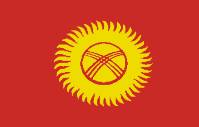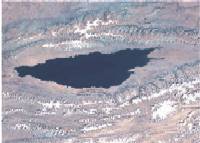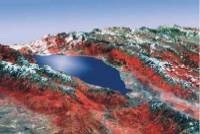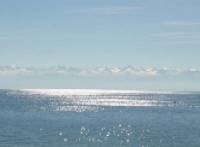Special Program for International Students
GRADUATE COURSE IN EARTH SCIENCE
& GEOENVIRONMENTAL SCIENCE
Current MEXT students
Jarkynai Usubalieva (Kyrgyzstan)
Email: s029218 @matsu.shimane-u.ac.jp
Thesis title: Evaluation of the history of environmental change in Lake Issyl-Kul, Kyrgyzstan, from bottom sediment geochemistry.
Supervisor: Prof. Hiroaki Ishiga (2004-2007).
Lake Issyk-Kul is a closed lake located in the Tien Shan mountain belt of Kyrgyzstan. It is the world's fifth deepest lake (668 m) and the second largest high altitude lake (1607 m above sea level). Issyk Kul is set in a compressional basin between two mountain ranges: the Kungei AlaToo, with elevations of up to 4771 m, to the north; and the Terskey AlaToo (up to 5216 m) to the south. Evidence suggests that Lake Issyk Kul has existed since Neocene time. Geological maps of the basin indicate that granitic, metamorphic, folded sedimentary rocks and glacial debris dominate the watershed, and contribute sediments and dissolved species to the lake. The lake level is controlled by the runoff of 60 rivers and springs fed by precipitation and mountain glaciers. Lake waters have a pH about 8.6-8.9 and are oversaturated with respect to calcite. Issyk Kul never freezes in winter due to its brackish salinity (6 g/l) and high altitude insolation.
In recent years, Lake Issyk-Kul has become a subject of special concern due to continuous fall of water level and contamination related to human activity. Changes in the lake water composition are mainly related to the decline of the lake level and to pollution resulting from the human occupation around the lake, including former mining activity. This research has been initiated to investigate the ecology of Lake Issyk Kul, due to concerns about environmental impacts resulting from possible leakage of radioactive wastes from uranium mining activity near its southern shore. Uranium was mined from the coal-bearing uranium deposit in the Kaji Sai Valley, and tailings impoundments contain 600,000 tonnes of radioactive wastes. The impoundments are currently unstable, with erosion of dams and degradation of protective and drainage systems.
Sedimentary geochemistry is the major focus of this work, to describe the environmental changes of the lake, as specifically related to potential contamination by uranium-bearing particles from the tailing ponds. Geochemical study of the lake sediments will be used to disclose the record of impacts produced in the lake environment. Uranium species and pathways and the amount of radioactive substances present will be evaluated to define geochemical behavior in brackish waters and the lake sediments, and the uranium hazard for the environment.
The analytical procedures that will be used include Ion Chromatography for water samples, and XRF and AAS for sediments. Determination of organic matter composition and radiocarbon ages are also very important to my study. My project will attempt to clarify the geochemical processes affecting Issyk-Kul, and to contribute to an environmental monitoring system.




